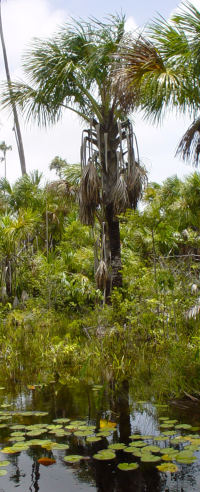
Mauritia flexuosa, known as the moriche palm, ité palm, ita, buriti, muriti, miriti, canangucho (Colombia), or aguaje (Peru), is a palm tree. It grows in and near swamps and other wet areas in tropical South America. It has been reported from Trinidad, Colombia, Venezuela, Guyana, Suriname, French Guiana, Brazil, Ecuador, Peru, and Bolivia.

The moriche oriole is a passerine bird in the New World family Icteridae. It is unrelated to Old World orioles. It is a breeding resident in the tropics of eastern South America. This bird is noted for its close association with the palm Mauritia flexuosa.
745 Mauritia is a dark background asteroid from the outer regions of the asteroid belt, approximately 24 kilometers in diameter. It was discovered on 1 March 1913, by German astronomer Franz Kaiser at the Heidelberg-Königstuhl State Observatory in Germany. The presumed carbonaceous C-type asteroid has a rotation period of 9.9 hours. It was named after Saint Maurice, patron of the Saint Mauritius church in the city of Wiesbaden, where the discoverer was born.

Fan palm as a descriptive term can refer to any of several different kinds of palms (Arecaceae) in various genera with leaves that are palmately lobed. Most are members of the subfamily Coryphoideae, though a few genera in subfamily Calamoideae also have palmate leaves. Fan palm genera include:

Acrocomia crispa, the Cuban belly palm or Corojo palm, a palm species which is endemic to Cuba. Formerly placed in its own genus, Gastrococos, recent work found that that genus was nested within Acrocomia. It is a tall, spiny palm with a trunk that is slender at the base, but swollen in the middle, giving it the name "Cuban belly palm" in English.
Coccothrinax fagildei or Fagilde's palm, is a palm which is endemic to Cuba.
Coccothrinax gundlachii (yuraguana) is a palm which is endemic central and eastern Cuba.
Coccothrinax inaguensis, the thatch palm or Inagua silver palm, is a palm which is endemic to the Bahamas.
Coccothrinax pauciramosa, the yuraguana or yuraguana vestida, is a palm which is endemic to Cuba. Like other members of the genus, C. pauciramosa is a fan palm. Trees are single-stemmed, between 2 and 5 metres tall with stems 4 to 8 centimetres in diameter. The fruit is purple-black, 0.7–1.2 cm in diameter.
Coccothrinax yunquensis, the yuruguana del Yunque, is a palm which is endemic to southern Cuba. It is reported to be restricted to El Yunque, a limestone mountain in Guantánamo Province.

Copernicia baileyana (yarey) is a palm which is endemic to eastern and central Cuba. Like other members of this genus, C. baileyana is a fan palm. Trees are 10 to 20 metres tall with stems 40 centimetres in diameter and are sometimes swollen. The fruit is black, 1.8 to 2.3 centimetres long and 1.8 to 2 cm in diameter.
Lepidocaryum is a monotypic genus of flowering plant in the palm family from South America where the lone species, Lepidocaryum tenue, is commonly called poktamui. Nine species names have been published but palm taxonomists agree that just one variable species includes them all. The most reduced member of the Lepidocaryeae, it is similar in appearance to three closely related genera, Mauritia, Mauritiella, and Lytocaryum. The genus name combines the Greek words for "scale" and "nut" and the species epithet is Latin for "thin".
Andrew James Henderson is a palm-systematist and Curator of the Institute of Systematic Botany at the New York Botanical Garden. He has authored taxonomic descriptions of 140 species, subspecies and varieties of plants, especially in the palm family

Acrocomia is a genus of palms which is native to the Neotropics, ranging from Mexico in the north, through Central America and the Caribbean, and through South America south to Argentina.

The Coryphoideae is one of five subfamilies in the palm family, Arecaceae. It contains all of the genera with palmate leaves, excepting Mauritia, Mauritiella and Lepidocaryum, all of subfamily Calamoideae, tribe Lepidocaryeae, subtribe Mauritiinae. However, all Coryphoid palm leaves have induplicate (V-shaped) leaf folds, while Calamoid palms have reduplicate leaf folds. Pinnate leaves do occur in Coryphoideae, in Phoenix, Arenga, Wallichia and bipinnate in Caryota.

Mauritia eglantina, the 'Dog-Rose Cowry' or 'Eglantine Cowry', is a species of sea snail, a cowry, a marine gastropod mollusk in the family Cypraeidae, the cowries.

Mauritia histrio, common name the harlequin cowry or the stage cowry, is a species of sea snail, a cowry, a marine gastropod mollusk in the family Cypraeidae, the cowries.

Mauritia is a genus of sea snails, marine gastropod molluscs in the family Cypraeidae, the cowries. These shelled molluscs are generally exclusive on the island of Mauritius, hence their name Mauritia.

John Shove "Bud" Palmer was an American professional basketball player. He was a member of the New York Knicks during the team's first three seasons in the Basketball Association of America, and was the leading scorer in the team's inaugural 1946–47 season. Palmer is considered to be one of the inventors of the jump shot.

The Calamoideae are a subfamily of the palm family Arecaceae containing 21 genera and about 620 species. They are found almost exclusively in the Old World tropics, but with three genera and a single species of Raphia in the New World tropics. Calamoideae includes the rattan palms, whose stems are harvested for the production of cane furniture and many other products. All species have fruits covered in distinctive overlapping scales.















